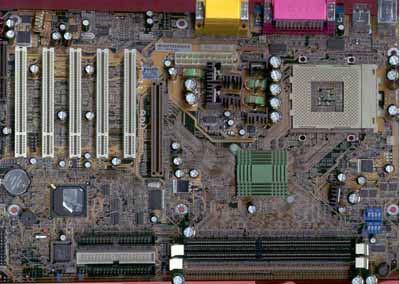
Original Link: https://www.anandtech.com/show/718
FIC AD11 Socket-A AMD 760 DDR ATX
by Anand Lal Shimpi on February 13, 2001 1:57 AM EST- Posted in
- Motherboards
Introduction
AMD's incredible success last year can be attributed to their high performance and very affordable Athlon processors. However little credit is given to the company that played a significant part in making it all possible. Without VIA, the Athlon would be without a home, luckily VIA was able to not only produce the KT133 chipset in great quantities but they also made it into a very reliable and mature platform for AMD's flagship.
Unlike Intel, AMD is not capable of supplying the market with both microprocessors and chipsets. The only reason we even see chipsets from AMD is that they do step in every now and then to promote new technology that they would like to see the third party vendors adopt. The most recent case in point being the 266MHz FSB and DDR SDRAM.
FIC has always been an avid AMD supporter. Because of their very close relationship to VIA, FIC has been producing motherboards for AMD platforms for the longest time, dating back to Socket-7 boards such as the ever so famous PA-2007. In more recent history they released the SD 11, which was one of the first Slot-A motherboards to ever hit the market in spite of strong pressures against supporting the platform from Intel. During the summer of 2000 FIC released their KT133 solution: the AZ11. Unfortunately, with boards like the ASUS A7V and the ABIT KT7-RAID, the AZ11 was somewhat disappointing in terms of feature set. What was even more disappointing was that we later discovered that the AZ11 had multiplier control after all, and the engineers simply failed to provide the dipswitches to control the settings. Had they properly done so, the AZ11 would have been the first Socket-A motherboard to break the Athlon's multiplier lock. Months later FIC released the AZ11E, a completely new design based on the same KT133 chipset, but basically what the original AZ11 should have been, just a few months too late.
Armed with another chipset from AMD, FIC has every reason to come out with another motherboard based on it. This time around, utilizing such features as the 266MHz FSB and DDR SDRAM, FIC is able to bring to market their first AMD 760 based motherboard. Back in September we offered a preview of the AD11 and we were quite impressed with its performance and stability, especially considering it was a very early beta platform.
Fast forwarding to the present day, we have the final, shipping revision of the FIC AD11 armed with the final, shipping revision of the AMD 760 chipset. How does it stack up to the KT133A and competing AMD 760 solutions of late? While it was the first AMD 760 board we laid eyes on, let's see how well FIC has improved the design since we first met.
|
FIC AD11 |
|
|
CPU
Interface
|
Socket-A
|
|
Chipset
|
AMD
760 Chipset
AMD 761 North Bridge VT 686B South Bridge |
|
Form
Factor
|
ATX
|
|
Bus
Speeds
|
100
/ 103 / 105 / 110 / 113 / 117 / 133 / 138 / 140 / 144 / 150 MHz
|
|
Core
Voltages Supported |
Auto Detect 1.475 / 1/700 / 1.725 / 1.750 / 1.775 / 1.800 / 1.825 / 1.850 V |
|
I/O
Voltages Supported |
3.3V
|
|
Memory Slots
|
2 184-pin
DDR DIMM Slots
|
|
Expansion Slots
|
1 AGP Slot 5 PCI Slots (1 Full Length) 1 CNR Slot |
|
On-board Audio
|
Analog
Logic C200 AC’97 CODEC
|
|
BIOS
|
Award
Modular BIOS 6.00PG
|
|
BIOS
Revision Tested
|
ABA41
|
The Layout
The physical layout of the AD11 hasn't changed much from the engineering sample we received last year. There are a few changes in terms of capacitors and dipswitches but other than that the layout remains the same. The board measures in at about 12" x 8.5" and the first thing we noticed was that the board exhibits a very "busy" design. We mean "busy" in the sense that there are traces and components all over the place. The less PCB you use when designing a motherboard, the cheaper the overall design will end up being and by cramming in as much as possible into such a small footprint FIC is clearly striving to do just that. This layout isn't all peaches and cream, there are a few caveats that are worth mentioning. Get out your red pens, it's time to do some grading.
For starters, and this is a complaint that we have voiced a number of times in other motherboard reviews, the CPU socket is placed too close to the right edge of the motherboard. With the amount of pressure required to mount Socket-A heatsinks, using a flat-head screwdriver to actually get the unit to lock isn’t too uncommon. But with the current position of the CPU socket, getting the screwdriver in between the heatsink clip and your power supply is quite difficult and borderline impossible (without causing damage to your CPU of course). The simple solution to this is to basically remove the power supply whenever installing/uninstalling your CPU or simply do so while the motherboard is out of the case if you are so permitted.
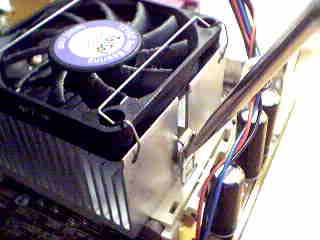
A screwdriver is required to unlock the heatsink. Notice how close the heatsink
is to the edge of the motherboard.
The power supply connector is placed to the left of the CPU socket, close to the audio / game ports. This can also be a problem, as the power cables will have to run over the CPU causing a hindrance to free airflow over your CPU. In order to avoid that problem, you have to make sure the power cables are tied up and carefully tucked out of the way.
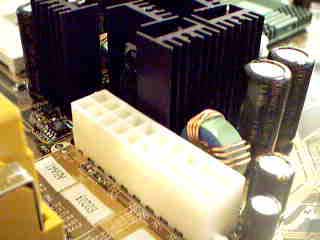
The power supply connector is very close to the tall heatsinks and capacitors.
The final issue we had with the layout was that the two DDR DIMM slots are placed close to the front edge of the motherboard. This forced FIC to relocate the IDE connectors to a position further left on the mainboard. The IDE connectors now block the use of some longer PCI devices, for example the Voodoo5 5000 PCI graphics card. In the end, only a single PCI slot is left completely unobstructed for accommodating full-length PCI cards. Fortunately it is rare that more than one full-length PCI card is used in a system like this, in most cases you won't have any full length cards to worry about.
If this were a server solution, FIC's grade report would have more red X's when it comes to the AD11's layout but since it's not we can simply say that a lot of this is due to the fact that the board is built on a very crowded design. Which would you prefer, a lower overall cost or more space to work with on a motherboard? The decision is yours.
Twin Turbos: PC2100 DDR & 266MHz FSB
The AMD 761 North Bridge is located down and to the left of the CPU socket. The 761 chip is undoubtedly the heart of the AD11. As you will remember from our review of the AMD 760 chipset, the North Bridge provides home to the 760's DDR SDRAM memory controller, the Athlon's EV6 bus interface and the AGP interface for the board as well.
The 761 North Bridge supports both 100MHz and 133MHz DDR FSB AMD processors. There seems to be quite a bit of confusion regarding the Athlon/Duron FSB frequencies mainly because they are advertised with reference to their effective transfer rate not actual operational frequency. To clarify, the Athlon's (and Duron's) EV6 bus either operates at 100MHz or 133MHz. Since the FSB is a DDR bus, the effective transfer rate is equal to that of a 200 or 266MHz FSB.
In terms of AGP support, the 761 North Bridge provides support for AGP 1X/2X and 4X transfer modes. As we have seen in previous tests, the tangible performance differences between AGP 2X and 4X are negligible, making this feature more of a checkbox that can be boasted about rather than something to be overly concerned about. Regardless, the 761 supports it and the AD11 uses it.
The AGP slot on the AD11 is a universal AGP slot meaning that it can accept all AGP cards, including 1.5V and 3.3V solutions. In the distant future motherboards will only be shipping with 1.5V AGP slots, but with the exception of the last generation of 3dfx AGP cards, most AGP graphics cards are keyed for 1.5V/3.3V operation.
The 761's DDR SDRAM memory controller is quite possibly the most attractive feature, at least on paper, that the AD11 has to offer. The board features two 184-pin DDR DIMM slots that support a total of 1GB of DDR SDRAM. One of the disadvantages to using DDR SDRAM is that the sheer number of traces, density of the termination circuitry and the difficulty with keeping a clean power signal supplied to the memory on these motherboards is so great that finding more than two DDR slots is rare. We experienced the same transition when PC133 SDRAM replaced PC100/PC66 SDRAM where we started seeing motherboards with only 3 DIMM slots instead of the conventional 4 slots.
The memory controller in the 761 supports both PC1600 (100MHz operating frequency) and PC2100 (133MHz operating frequency) DDR SDRAM. Unlike the previous Athlon chipsets, the AMD 760 does not allow you to run the FSB and memory bus asynchronously. In fact, this is true for all DDR Athlon chipsets. According to motherboard manufacturers, due to the extreme precision required when dealing with DDR SDRAM timings it is very difficult to run the memory and the FSB at two different speeds. Since both the memory and front side buses are DDR buses, they can both run at 100MHz DDR or 133MHz DDR and alleviate some of these potential issues.
What that means is that even if you have some PC2100 memory, which is capable of running at 133MHz, you won't be able to take advantage of it if you are running your FSB at 100MHz; your PC2100 DDR SDRAM quickly becomes an expensive version of PC1600 SDRAM. The motherboard will automatically detect your FSB speed and run the memory bus at the same frequency. Fortunately, since unlocking Socket-A processors is not a difficult job at all, you should be able to lower the clock multiplier of your CPU and bump the FSB up to 133MHz so that you can take advantage of the faster memory.
We kicked off this review mentioning that AMD is not a chipset manufacturer, they are a CPU manufacturer. Without the ability to mass manufacturer chipsets, AMD cannot remain competitive with the ALis and VIAs of the world when it comes to overall cost. The AMD 760 chipset, by definition, consists of the AMD 761 North Bridge and the AMD 766 South Bridge connected by the PCI bus. However, due to the cost of the AMD 760 chipset, using both the 761 North Bridge and the 766 South Bridge can substantially increase the price of the motherboard. Conveniently enough, the AMD 766 South Bridge happens to be pin-compatible with the VIA 686B South Bridge. So it takes FIC little more than a walk down to the street to VIA in Taipei to outfit the AD11 with VIA's more cost effective 686B South Bridge instead of using AMD's 766. This makes both companies happy as AMD isn't in the market to sell chipsets and VIA is however their DDR solution is not shipping in mass quantities. This way, AMD gets the DDR exposure in the market they are hoping for and VIA ships more South Bridges.
The VIA 686B South Bridge features Ultra ATA 100 support, it's only improvement over its predecessor, the 686A. As with all integrated IDE controllers, the 686B provides two IDE channels that can connect up to four IDE devices (two per channel).
The 686B South Bridge also features a second USB root hub. Two traditional USB ports are mounted at the back of the motherboard together with the serial / parallel ports while there are headers ready for the third and fourth USB ports between the fourth and fifth PCI slots. Unfortunately, FIC does not include any extra USB headers with the AD11, which is necessary if users want to use the third and fourth USB ports.
The 5/1/0/1 (PCI/AGP/ISA/CNR) expansion slot design, although not ideal, should be enough for most users. Instead of providing support for a standalone CNR slot, we would have liked to see FIC implement a shared slot design at least where a sixth PCI slot would be shared with the CNR slot.
Even though the VIA 686B South Bridge features a PCI to ISA bridge, FIC didn’t take advantage of it. Instead FIC decided to include the CNR slot we just introduced. Although the enthusiast market is growing rapidly, FIC still largely depends on the OEM market where the majority of sales still come from; keeping the CNR slot helps OEMs provide a low cost modem solution for end users. While CNR is a more up to date standard than AMR, its actual use in the marketplace has yet to be proven.

For onboard audio, FIC uses the Analog Logic C200 AC’97 audio CODEC. Once again, it is capable of providing basic sound for normal users, but for anything more, you really should go with a hardware-based PCI sound card.
Tweaking made easy
Regardless of how you paint the picture, this is an enthusiast's market. Because it is so, tweaking and overclocking are two very important issues when looking at any motherboard. We have recently been devoting quite a bit of time to covering the KT133A based solutions and have found them to be quite tweak-friendly, can the same be said about AMD 760 based motherboards? As far as the FIC AD11 is concerned, you can put your fears to rest as there are quite a few settings the AD11 let's you configure on your own to get the most out of your system.
As we outlined in our Socket-A Overclocking Guide, multiplier adjustment is key to getting the most effective overclock out of your processor. Just as the AZ11 had the multiplier adjustment circuitry already on the board, the same was true for the AD11 we looked at last September. In the shipping revision of the AD11, what we are looking at today, FIC implements clock multiplier adjustment through a set of dipswitches called the ADR switch, allowing values from 5.0x to 12.5x. In order to take advantage of these adjustable ratios you will first need to unlock your CPU, and then set a jumper to enable the dipswitch settings.
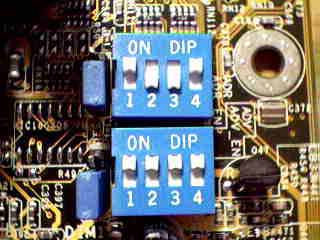
The two sets of dipswitches: ADR and ADV
The more you push your CPU, the more tolerance levels become an issue. One way to combat this is by simply increasing the voltage supplied to your processor. The voltage itself won't harm your CPU (as long as you remain within AMD's specified operating range) however the same can't be said for the added heat/stress caused by overclocking. For anyone that has had any experience overclocking, a decent voltage boost doesn't generally result in permanent CPU damage however we take no responsibility for any of the after effects; neither does FIC. In order to offer the ability to do so, FIC does provide another set of switches, called the ADV switch that allow you to select from the following list of core voltage settings: 1.475 / 1.700 / 1.725 / 1.750 / 1.775 / 1.800 / 1.825 / 1.850 V. Like the multiplier settings, these core voltage options must be set from the dipswitches and there is no utility in the BIOS to do this for you.
The available FSB settings are somewhat disappointing for the AD11. The available FSB frequencies that are offered are: 100 / 103 / 105 / 110 / 113 / 117 / 133 / 138 / 140 / 144 and 150MHz. Unfortunately this results in quite a few large jumps between FSB frequencies, which can be the limiting factor in FSB overclocking. As shown in our overclocking tests, we were able to push the FSB speed to 140MHz without a hitch. However at 144MHz, the system passed the POST but wasn’t able to locate the boot sector of the hard drive correctly and failed to load Windows. This was probably a limit of the DDR SDRAM being used or a combination of that and the board itself. Remember that a 11MHz increase in FSB frequency translates into an effective 22MHz increase because you're dealing with DDR front side and memory buses. We know the limitation doesn't exist with the FSB since we have gotten KT133A boards up higher than 140MHz, leaving the DDR SDRAM as the major culprit here. In the end, the smaller the FSB increments you have, the more precise overclocking you can do since the system may have been just fine at 142MHz but not 144MHz.
We came across a very interesting anomaly during our testing of the AD11. Because the AGP clock divider must change depending on whether you are running at the 100MHz or 133MHz FSB (AGP clock = 66MHz = FSB * 2/3 or FSB / 2) there is a jumper that selects 100 or 133MHz FSB operation (the jumper really just selects the AGP ratio and enables the FSB speeds accordingly). However, for each setting, you are able to choose the entire range of FSB speeds in the BIOS, and that creates some problems. During our testing, initially we had the jumper set to 100MHz and ran the CPU at 100MHz flawlessly. Then we turned off the system, set the jumper to 133MHz, reduced the multiplier ratio from 10 to 7.5, and the system didn’t POST at all.
In the end we discovered that the problem was related to the FSB speeds in the BIOS and the jumper states. Before you change the jumper from 100MHz to 133MHz, you will have to go into the BIOS and change the FSB speed to 133MHz and reboot. The reboot will fail and board won't POST. Next, you have to turn off your system, and manually change the jumper to 133MHz. Now boot up the system and it will run at 133MHz without a hitch. Moving back from 133MHz to 100MHz requires the same process. This is entirely too much work to do what should simply be manipulation of a single setting either in the BIOS or on the motherboard. Hopefully FIC will address this issue with a future BIOS update.
Speaking of BIOS functions, there are a number of memory tweaking options that are present within the AD11's BIOS setup. The most influential setting being the CAS Latency which our test DDR SDRAM DIMM allowed us to run at a setting of 2 instead of 2.5 which was what we were limited to when we first looked at the AD11.

Smart Modular Technologies 128MB PC2100 CAS2 DDR SDRAM module
Our initial experiences with the AD11 were quite positive back in September, especially considering that it was a very early beta then. Now five months later, the AD11 proves to be one of the most stable motherboards we have seen. FIC puts a total of fifteen 2200uF and ten 1000uF capacitors around the CPU socket, AMD 761 North Bridge, as well as the DDR DIMM slots. All the MOSFETs around the CPU socket are mounted to heatsinks to aid cooling.
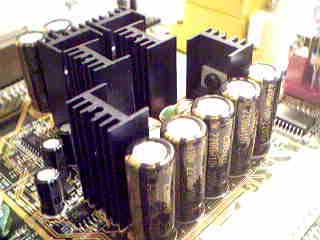
The capacitors and the heatsink for the MOSFETs are placed together
Even when running the DDR SDRAM at CAS 2 settings, the system did not crash once within 24 hours of our stress tests. We continued to run the stability tests and finally the first crash occurred after 34 hours of operation. Considering that this is FIC's first try at a DDR board we were very impressed with the stability of the AD11.
One thing to look out for is that after hours of testing, we noticed that the heatsinks on the MOSFETs got quite hot, as did the heatsink on the AMD 761 North Bridge. Therefore careful cooling around the CPU area becomes essential in keeping the system stable.
Two fan headers are available on the motherboard, one for the CPU and one for the chassis fan. The VIA 686B Super South Bridge has an integrated hardware monitor, and it monitors the speed of those two fans as well as up to two temperatures.
FIC continues to include their NOVUS II enhanced motherboard features on the AD11. BIOS Guardian basically acts as a firewall against all virus infection of the BIOS data. You will have to disable this setting before you can flash your BIOS. Easy Key provides shortcuts for users to get into specific sub-menus in the BIOS, and Clockometer is a software interface for Windows 98 users to overclock their systems from within Windows.
The fourth feature of NOVUS II is LogoGenie that allows users to customize, create, or select a logo to display during bootup. The software currently supports only Windows 95/98, so users with other operating systems won’t be able to take advantage of the feature. This feature isn't be that useful for most users, but remember, FIC is a major player in the OEM market and LogoGenie and easily allows OEM builders to include their own logos during boot up.
Last of all, FIC includes Audio Alert II as an optional diagnosing tool. Users can connect the Audio Alert II module to a speaker and every time you boot up the machine the module will tell you if any part of the system is experiencing problems. Motherboard diagnostics have come quite a way since the days of simple beep codes.
The manual included with the AD11 has brief instructions on how to install the motherboard as well as its unique features, however it lacks some pictures that would be more helpful. All the jumpers and connectors are listed, but again detailed explanation is not provided. FIC does include explanations of BIOS settings, but they do not provide any information on software and driver installation. FIC provides two CDs with the AD11: one containing all the necessary drivers and utilities, and the other featuring Norton Ghost, Norton Antivirus, and Norton Virtual Drive.
The Test
In recent times, choosing a motherboard cannot be completely determined by a Winstone score. Now, many boards come within one Winstone point of each other and therefore the need to benchmark boards against each other falls. Therefore you should not base your decision entirely on the benchmarks you see here, but also on the technical features and advantages of this particular board, seeing as that will probably make the greatest difference in your overall experience.
Click Here to learn about AnandTech's Motherboard Testing Methodology.
|
Test Configuration |
|
| Processor(s): |
AMD
Athlon (Thunderbird) 1GHz
|
| RAM: |
1
x 128MB Mushkin PC133 SDRAM
1 x 128MB Smart PC2100 DDR SDRAM |
| Hard Drive(s): |
Western
Digital 153BA Ultra ATA 66 7200 RPM
|
| Chipset Drivers: |
AMD
AGP Miniport Driver 4.80
VIA IDE Bus Master Driver 2.1.50 VIA IRQ Routing Driver 13a |
| Video Card(s): |
NVIDIA
GeForce 2 GTS 32MB DDR
|
| Video Drivers: |
NVIDIA
Detonator 5.22
|
| Operation System(s): |
Windows
98 SE
|
| Motherboard Revision: |
FIC
AD11 Revision 1.2
|
?/p>
|
Windows 98 Performance |
|||
|
Athlon 1GHz OEM |
SYSMark 2000 |
Content Creation Winstone 2000 |
Quake 3 Arena 640x480x16 |
|
FIC AD11 (AMD 760 / 133MHz) |
202 |
38.5 |
162.4 |
|
ABIT KT7A-RAID (KT133A / 133MHz) |
197 |
37.4 |
149.6 |
|
ASUS A7V133 (KT133A / 133MHz) |
197 |
37.6 |
153.4 |
|
EPoX EP-8KTA3 (KT133A / 133MHz) |
196 |
36.7 |
146.3 |
|
MSI K7T Turbo (KT133A / 133MHz) |
194 |
37.5 |
145.7 |
|
MSI K7T Pro2 (KT133 / 100MHz) |
189 |
35.8 |
135.1 |
All of the SDRAM tested in this quick comparison, both DDR and SDR, was set to operate at CAS 2 at the most aggressive memory timings possible.
Here we see the performance benefit that DDR SDRAM offers over conventional PC133 SDRAM.?Unfortunately the only thing holding back DDR from widespread acceptance now is the fact that so many people have enough PC133 SDRAM that they do not wish to upgrade at this point in time.?DDR SDRAM needs to carry a more attractive price tag before people will begin to switch, either that or the performance improvement must be more pronounced.?
Final Words
The AD11 was the first AMD 760 board we ever tested back in September and it's the first individual AMD 760 motherboard review that we're publishing. And without a doubt the AD11 proves itself to be a solid contender in the Socket-A motherboard market. Its performance is impressive and the motherboard is extremely stable. FIC did an exceptional job in building a rock solid DDR motherboard.
On the other hand, the layout of the board is falls below average. The placements of the CPU socket, power supply connector, and the IDE / floppy connectors are not in the most ideal places. This is the sacrifice FIC had to make in order to maintain such a low profile ATX motherboard.
Something that is inexcusable however is the fact that FIC continues to refrain from allowing for clock multiplier, voltage and FSB manipulation solely from within the BIOS. The days of jumper-controlled motherboards are long gone and while dipswitches are slightly better, with the competition already boasting 100% jumperless designs it is time for FIC to do the same. If they are worried about upsetting OEM customers that prefer the dipswitches they can just as easily go the same route as ABIT and provide both, dipswitches and a jumperless utility.
If you want the best performance for Athlon systems, the AD11 is definitely on the list of boards to consider. Together with PC2100 DDR SDRAM, we have already seen how impressive the combo is. However, with the motherboard being almost 30% more expensive than conventional KT133A motherboards and the need to pay a premium for DDR SDRAM, this setup might prove to be too much of an investment.
It will still be a while before we start to see the added bandwidth of DDR SDRAM fully taken advantage of, so if you don't mind not having the fastest thing on the block, a KT133A with a decent amount of PC133 SDRAM may be your best option for now. Otherwise, you can be one of the early adopters and hop on the DDR SDRAM bandwagon. It will only earn you a 5 - 10% performance gain in most situations but for some that's enough to justify the cost; if it isn't, then there is a world of KT133A boards waiting to catch your eye.
How it Rates
|
AnandTech Motherboard Rating |
|
|
Rating (x/10)
|
|
|
Performance
|
6.0
|
|
Price
|
4.0
|
|
Stability
|
9.0
|
|
Quality
|
6.0
|
|
Features
|
7.5
|
|
Layout
|
4.5
|
|
Availability
|
6.5
|
|
Documentation & Software Bundle
|
6.0
|
| Overall Rating - not an average Click here to find out why |
6.5
|

